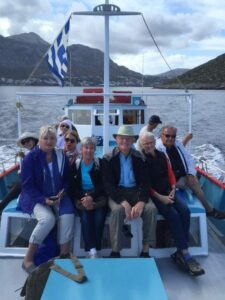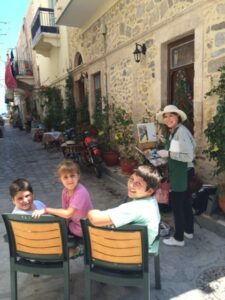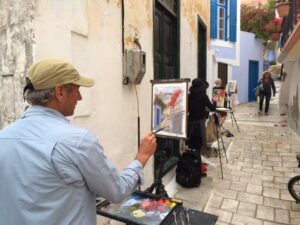
Golf and painting are challenging and fun but they are also frustrating. In golf, some days you’re hitting the ball like a pro and other days you’re just shanking and slicing from the rough to the sand traps and back. Painters have the same problem: some days the stars align and the painting just flows. More often you’re struggling, desperately trying to get it on canvas. Both painters and golfers wonder who snuck into the garage at night and switched out all of our equipment.


The gods of both golf and painting play the same game with your head: when you’re just about to give up and throw your clubs in the lake or your paints in the trash, the gods give you a birdie or a sweet painting and pull you back in (think of Al Pacino in the Godfather). Painting has mental sand traps as challenging as the ones on the golf course. There are techniques for “getting out” but it takes lots of study and practice.
Weather is a factor. Both golfers and painters hate wind and rain. Some golfers use brightly colored balls to play in the snow. Some painters keep their white paint in their pockets so it won’t freeze in the snow. Both activities also require special umbrellas and clothing. Oh boy, an excuse to buy more stuff!
Lots of doctors and lawyers play golf and I’m meeting more and more doctors and lawyers in workshops. They’re focused, determined and have the latest top-of-the-line stuff. Men dominated both activities in the beginning, but now women want to be frustrated, I mean challenged, too.

Travel to new places is exciting for both golfers and painters. Vacations to golf courses all over the world are very popular. Then golfers gather at parties, drink and compare notes on the courses they’ve played. Artists love to travel to paint, drink and compare notes on where to find turpentine in foreign countries. Travel gear is a challenge for both activities. Golf clubs are bulky and may incur extra airline charges. Paints, tripods and other painting gear require special packing and cannot be carried on. Both groups hold their breath until their precious cargo appears on the baggage ramp at their destination. Phew–there’s my bag!
When I was growing up my parents used to joke that they were spending our inheritance on golf clubs, shoes and paraphernalia. There was always a new gadget or golf ball that would improve their game. An entire side of our garage was devoted to golf stuff. Painters have the same opportunity to taunt their kids with how much money they’re spending on “stuff.” Exciting conventions offer tempting new paints, brushes, view finders, frames and videos that will change our “game.”

My mom took golf lessons for 40 years. She would be convinced that each new golf pro was “the best ever” and was going to lower her handicap. (There’s a thought: why don’t artist’s have handicaps? it would make sense when signing up for workshops, entering shows, etc. “Artists with a handicap above 12 need not apply.”) Back to my mom: she took copious notes in little spiral notebooks, bought books by masters like Arnold Palmer and Gary Player, and watched golf TV on weekends. I have dozens of sketchbooks with workshop notes and, like my mom, am convinced that each new instructor’s palette choices, etc., are just what I needed to conquer the art. The painting videos are endless and serve 2 purposes: they instruct and entertain, just like the golf TV did for my folks. Unlike my parents’ golf TV shows, I can pop a DVD in or even download a YouTube demo any time I want, not just on weekends. (Here’s a personal note to my kids: you can toss it all when I’m gone.)

Golfing buddies or artist buddies: if you’re lucky, you’ve got ‘em. The best friends will encourage you when you’ve had a lousy day and you’ll do the same for them. The shared experience, whether on the golf course or on a painting site will be revisited again and again. “Remember that time we…(were caught in a monsoon on the 9th hole…were chased by a bear while painting in Yosemite…)? Speaking of friends, golfing buddies or artist buddies, they’re the best!

Whether you’re a professional or not, standing on the first tee looking out at a sea of green grass or you’ve set up your easel on a dock with a view of the Aegean sea, every beginning is filled with hope and the joy of just being out there in the fresh air. You smile at your buddies, pick up your driver or brush, and go for it.
Art in Cuba and the Traveling Painter
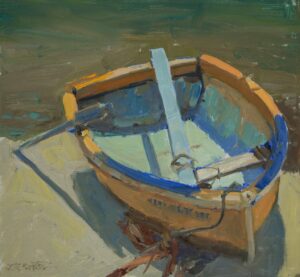
There are no starving artists in Cuba. One reason for this is that each person receives food from the government each month: one quarter of a chicken, 5 eggs and 5 pounds each of rice, black beans and sugar. (Sugar is cheap in Cuba and health care is free to the rising numbers of diabetics.) Artists there make more money than doctors, lawyers or university professors. Why? Because they are not, like the others, state employees, and are able to keep more of what they make. Again, why? Because Castro considers them cultural ambassadors and curators, and very important to keeping the Cubans….Cuban. Would it be worth it to live in Cuba, with the restrictions that entails, to be at the top of the food chain for a change? Not for me. But I can tell you that in many ways the young, hip, vibrant artists that I recently met on my trip to Havana were no different from artists here in the U.S. They were enthusiastic about their current work, complained about the price of art supplies which had to be imported from Europe and knew how to party. The Art gene is a powerful one.
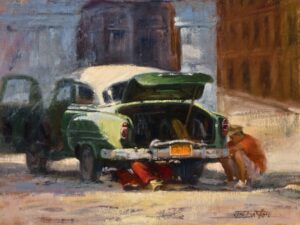
I’ve just started paintings from that wonderful trip. The Cubanos are a beautiful, friendly group. The city of Havana reminds me of a stunning woman “of a certain age” whose beauty is still there under the surface of time’s wear, and I don’t know what they do to the black beans and rice (known as “Moors and Christians”) but my mouth waters just thinking about them. The Buena Vista Social Club music is in the air and makes you want to get up and dance in between endless rounds of mojitos and pina coladas. Oh, and then there are the cars–I took 360 photos of mid-century Chevys, Buicks and even one of the few 1956 Lincoln Continental Mark Twos in the western hemisphere. My first painting, shown here, is a common scene in Havana: a car is stopped dead on a city street and Cubanos are all over it, once more figuring out how to make it run again with no parts and no gas. That’s what I really loved about the people–they may be captive on their little island, but they sure know how to, in the words of Tim Gunn, “make it work.”
I wasn’t able to paint on this trip, but I’m often asked about the nuts and bolts of managing it all. Travel with art supplies takes some careful preparation. Finding art stores can be challenging, if not impossible, in some countries. Besides that, we all have our favorite colors and canvas surfaces and painting in a foreign country can be intimidating enough without trying to make do with unfamiliar supplies. Since 9/11 the rules regarding combustibles are strict. I often avoid the problem by taking watercolors, but even then those little tubes often look suspicious to a TSA agent. I’ve had no trouble (so far) packing oil paints in my luggage and I thought I’d share what I do, with the understanding that we can but try…

1.) Before you leave, try to determine how many canvases you’ll be able to complete each day: one in the morning, one in the afternoon, one for good luck? How much paint will you need? If you don’t know how much paint you use in a week or two, start keeping track of what you use before you leave. You’ll probably need a lot of white paint and small (37ml) tubes of colors you use regularly, but just half a tube of specialty colors, like reds for flowers. Paint tubes are heavy, so find out the weight limit for your airline and pack carefully to avoid extra baggage charges.
2.) I make sure that I include a very visible note (see below) to the TSA on the outside of a double zip lock bag of paints. The note assures the TSA people that the contents are not combustible. I learned on the Gamsol site and others NEVER to refer to the contents as “paint”! The double bag is because the paints might pop open due to baggage hold pressure and you probably don’t want to wear dioxizine purple all over your clothes…for a week.
ATTN: TSA
THESE ARTIST COLORS ARE MADE FROM VEGETABLE OIL AND
CONTAIN NO SOLVENT.
ARTIST GRADE COLORS ARE VEGETABLE BASED WITH A
FLASH POINT ABOVE 550.
THEY ARE NOT HAZARDOUS.
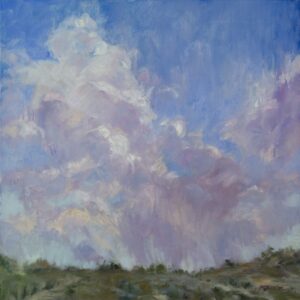
3.) The next question is how to transport those precious wet canvases home. Once you know how many canvases you think you’ll need, there are several ways to carry and pack them efficiently. On my first trip to France I precut my 8 x 10” canvas with a 1/2 inch border around them. I carried three or four 1/8 inch gator boards that were another half inch larger than the canvas. (Wildlife painter Carl Rungius just thumbtacked the corners, so you can try that.) At the end of a painting session I pulled the wet canvas off the board, set it aside to dry, and taped a fresh one on for the next day. You can bring dozens of canvases this way with a minimum of weight and space. By the end of the trip–a week or two–the first canvases are pretty dry and can safely be stacked with sheets of waxed paper between them. The wet ones can be mounted on both sides of the boards and taped together with push pin “spacers”, then wrapped tightly in plastic for the trip home. You can also use a light weight card board wet box to transport them home. On my last trip to Italy, I brought Raymar’s Featherweight boards and loved them. Whatever method you decide to use, it helps to bring just one size board so they’ll stack and pack easily. You can always adjust the size with tape if you decide you need a different shape for a particular subject.
4.) Be sure to carry on the things you can’t live without. I carry a 2 to 3 oz. plastic bottle of Liquin in my carry on “liquids” bag and add a little of it each day to my white paint. That ensures that most of the colors will have some drying agent in them to help speed up the process. I carry on my brushes. We all have our favorites and are unlikely to find them in little out of the way towns). I also include a few canvases, boards and masking tape. These are the things that are hard to replace if my bag gets lost for a few days.
5.) Needless to say, you cannot pack or carry on Gamsol or turps–the first adventure in each town is finding some at a hardware store or art store if they have one! It helps if you can look up the words for “turpentine”, “mineral spirits”, “solvent” and “odorless” and write them down before you leave the country.
6.) I also make sure that my brush washer container is as odor free as I can make it–I wash it out in soapy water and double zip lock bag it to avoid having any problem there. I pack my palette knife in my luggage, too, and pray for it’s safe arrival.
7.) Finally, my “insurance kit”: I always carry on a very compact kit of watercolor paper, paints squeezed out in palette cups and left out to dry before I pack them, brushes and old film containers for water–if the oils don’t make it for a while, I still can hit the ground running and start painting when I arrive in town.
There are no guarantees and the rules change, so be sure to check airline websites before you leave, but these ideas have worked for me and I’ve had so many wonderful experiences painting abroad! I hope you’ll share any travel tips you’ve discovered in your travels with us on this blog. Happy painting–wherever you may be!
“A journey is a person in itself; no two are alike. and all plans, safeguards, policies and coercion are fruitless, we find after years of struggle that we do not take a trip; a trip takes us.” John Steinbeck
Is There A Heaven For Paintings?
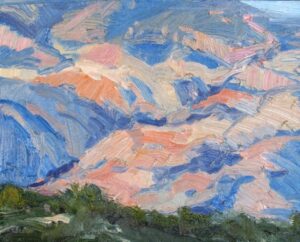

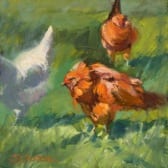
5 Stages of Painting
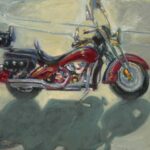
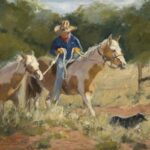
I was teaching in my studio recently and glanced at the bulletin board that I’ve loaded with sketches, ideas and quotes. I had written down the 5 stages of grief at some point and laughed (yes, laughed) at how the same list applies to the work of an artist. If you are an artist I think you’ll be able to relate to this. If you’re a collector, this will give you some idea of how hard our work can be, but you also might find the list applies to your own work, whatever that may be. And, as in life, these stages don’t just run their course and then “you’re done.” They keep repeating. And we keep trying to paint that perfect painting. All artists have a studio full of paintings that will never see the light of a show, but the ones that work make it all worth while!
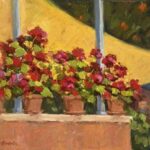
Here’s an idea of what these stages mean to me:
Denial: This is not bad…not the painting I had in my head when I started…but maybe this will work…
Anger: Why isn’t this working? Why can’t I find that color? Why can’t I draw a horse?
Bargaining: OK, if you (the Art God?) just let me get this one painting done in time for the show, I promise I’ll clean up my studio and give up popcorn…and maybe ice cream.
Depression: This is never going to work. What made me think I could paint?
Acceptance: Well, this is not bad. This is going to work for now and the next one will be even better. I hope. I just have to keep working at it and I will get as close as I can before I die.
Repeat 5 stages of Painting. Order may be shuffled as needed.
Good Luck! And don’t give up!
Art in Cuba and the Traveling Painter

Artists there make more money than doctors, lawyers or university professors. Why? Because they are not, like the others, state employees, and are able to keep more of what they make. Again, why? Because Castro considers them cultural ambassadors and curators, and very important to keeping the Cubans….Cuban.
Would it be worth it to live in Cuba, with the restrictions that entails, to be at the top of the food chain for a change? Not for me. But I can tell you that in many ways the young, hip, vibrant artists that I recently met on my trip to Havana were no different from artists here in the U.S. They were enthusiastic about their current work at the Biennial, complained about the price of art supplies which had to be imported from Europe and knew how to party. The Art gene is a powerful one.
I’ve just started paintings from that wonderful trip. The Cubanos are a beautiful, friendly group. The city of Havana reminds me of a stunning woman “of a certain age” whose beauty is still there under the surface of time’s wear, and I don’t know what they do to the black beans and rice (known as “Moors and Christians”) but my mouth waters just thinking about them. The Buena Vista Social Club music is in the air and makes you want to get up and dance in between endless rounds of mojitos and pina coladas.

Traveling Tips for Oil Painters
I wasn’t able to paint on this trip, but I’m often asked about the nuts and bolts of managing it all. Travel with art supplies takes some careful preparation. Finding art stores can be challenging, if not impossible, in some countries. Besides that, we all have our favorite colors and canvas surfaces and painting in a foreign country can be intimidating enough without trying to make do with unfamiliar supplies.
Since 9/11 the rules regarding combustibles are strict. I often avoid the problem by taking watercolors, but even then those little tubes often look suspicious to a TSA agent. I’ve had no trouble (so far) packing oil paints in my luggage and I thought I’d share what I do, with the understanding that we can but try…
- Before you leave, try to determine how many canvases you’ll be able to complete each day: one in the morning, one in the afternoon, one for good luck? How much paint will you need? If you don’t know how much paint you use in a week or two, start keeping track of what you use before you leave. You’ll probably need a lot of white paint and small (37ml) tubes of colors you use regularly, but just half a tube of specialty colors, like reds for flowers. Paint tubes are heavy, so find out the weight limit for your airline and pack carefully to avoid extra baggage charges.
- I make sure that I include a very visible note (see below) to the TSA on the outside of a double zip lock bag of paints. The note assures the TSA people that the contents are not combustible. I learned on the Gamsol site and others NEVER to refer to the contents as “paint”! The double bag is because the paints might pop open due to baggage hold pressure and you probably don’t want to wear dioxizine purple all over your clothes…for a week.
ATTN: TSA
THESE ARTIST COLORS ARE MADE FROM VEGETABLE OIL AND
CONTAIN NO SOLVENT.
ARTIST GRADE COLORS ARE VEGETABLE BASED WITH A FLASH POINT ABOVE 550.
THEY ARE NOT HAZARDOUS. - The next question is how to transport those precious wet canvases home. Once you know how many canvases you think you’ll need, there are several ways to carry and pack them efficiently. On my first trip to France I precut my 8 x 10” canvas with a 1/2 inch border around them. I carried three or four 1/8 inch gator boards that were another half inch larger than the canvas. (Wildlife painter Carl Rungius just thumbtacked the corners, so you can try that.) At the end of a painting session I pulled the wet canvas off the board, set it aside to dry, and taped a fresh one on for the next day. You can bring dozens of canvases this way with a minimum of weight and space. By the end of the trip–a week or two–the first canvases are pretty dry and can safely be stacked with sheets of waxed paper between them. The wet ones can be mounted on both sides of the boards and taped together with push pin “spacers”, then wrapped tightly in plastic for the trip home. You can also use a light weight card board wet box to transport them home. On my last trip to Italy, I brought Raymar’s Featherweight boards and loved them. Whatever method you decide to use, it helps to bring just one size board so they’ll stack and pack easily. You can always adjust the size with tape if you decide you need a different shape for a particular subject.
- Be sure to carry on the things you can’t live without. I carry a 2 to 3 oz. plastic bottle of Liquin in my carry on “liquids” bag and add a little of it each day to my white paint. That ensures that most of the colors will have some drying agent in them to help speed up the process. I carry on my brushes. We all have our favorites and are unlikely to find them in little out of the way towns). I also include a few canvases, boards and masking tape. These are the things that are hard to replace if my bag gets lost for a few days.
- Needless to say, you cannot pack or carry on Gamsol or turps–the first adventure in each town is finding some at a hardware store or art store if they have one! It helps if you can look up the words for “turpentine”, “mineral spirits”, “solvent” and “odorless” and write them down before you leave the country.
- I also make sure that my brush washer container is as odor free as I can make it–I wash it out in soapy water and double zip lock bag it to avoid having any problem there. I pack my palette knife in my luggage, too, and pray for it’s safe arrival.
- Finally, my “insurance kit”: I always carry on a very compact kit of watercolor paper, paints squeezed out in palette cups and left out to dry before I pack them, brushes and old film containers for water–if the oils don’t make it for a while, I still can hit the ground running and start painting when I arrive in town.

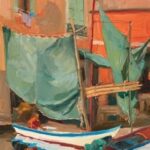
There are no guarantees and the rules change, so be sure to check airline websites before you leave, but these ideas have worked for me and I’ve had so many wonderful experiences painting abroad! I hope you’ll share any travel tips you’ve discovered in your travels with us on this blog. Happy painting–wherever you may be!
“A journey is a person in itself; no two are alike. and all plans, safeguards, policies and coercion are fruitless, we find after years of struggle that we do not take a trip; a trip takes us.”
-John Steinbeck
